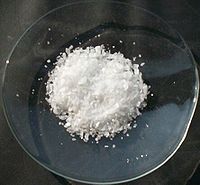
Photo from wikipedia
Abstract Human biomonitoring is a powerful approach in assessing exposure to environmental pollutants. Flame retardants (FRs) are of particular concern due to their wide distribution in the environment and adverse… Click to show full abstract
Abstract Human biomonitoring is a powerful approach in assessing exposure to environmental pollutants. Flame retardants (FRs) are of particular concern due to their wide distribution in the environment and adverse health effects. This article reviews studies published in 2009-2020 on the chemical analysis of FRs in a variety of human samples and discusses the characteristics of the analytical methods applied to different FR biomarkers of exposure, including polybrominated diphenyl ethers (PBDEs), hexabromocyclododecane (HBCD), novel halogenated flame retardants (NHFRs), bromophenols, incl. tetrabromobisphenol A (TBBPA), and organophosphorous flame retardants (PFRs). Among the extraction techniques, liquid-liquid extraction (LLE) and solid phase extraction (SPE) were used most frequently due to the good efficiencies in the isolation of the majority of the FR biomarkers, but with challenges for e.g. highly lipophilic FRs. Gas chromatography-mass spectrometry (GC-MS) is mainly applied in the instrumental analysis of PBDEs and most NHFRs, with recent inclusions of GC-MS/MS and high resolution MS techniques. Liquid chromatography-MS/MS is mainly applied to HBCD, bromophenols, incl. TBBPA, and PFRs (including metabolites), however, GC-based analysis following derivatization has also been used. Developments are noticed towards more universal analytical methods, which enable widening method scopes in the human biomonitoring of FRs. Challenges exist with regard to sensitivity mainly due to the low concentrations of FRs in the general population and limited sample material for some human matrices. A strong focus on quality assurance/quality control (QA/QC) measures is required in the analysis of FR biomarkers in human samples, related to their variety of physical-chemical properties, low levels in most human samples and the high risk of contamination.
Journal Title: Analytica Chimica Acta
Year Published: 2021
Link to full text (if available)
Share on Social Media: Sign Up to like & get
recommendations!